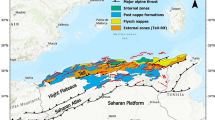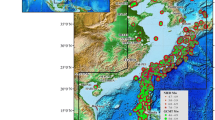Abstract
The existence of several magnitude scales in the compiled earthquake catalogs of a specific region has made the development of regional relations connecting magnitude scales a necessity, especially for creating a homogeneous seismic catalog in which all magnitudes should be converted to a preferred magnitude scale. To consistently estimate all magnitude ranges and avoid the saturation problem for large earthquakes, the preference is always given to the moment magnitude Mw scale, wherein the most complete and reliable catalog used worldwide is the Global Centroid Moment Tensor (GCMT). However, to our knowledge, no study has yielded regional (in Algeria) relationships for converting different magnitudes to the moment magnitude (Mw,GCMT). The main reason is typically due to the lack of data pairs of different magnitude scales with Mw (GCMT). To overcome this issue, in this research paper, the moment magnitudes data used for northern Algeria (the area bounded by 32° to 39° N and 3° W to 10° E) have been taken principally from the GCMT catalog and enhanced with the European–Mediterranean Regional Centroid Moment Tensor catalogs RCMT and ZUR-CMT. Regarding this latter, it has been demonstrated in the literature that for the Mediterranean regions, a minor correction should be addressed before merging its data with the GCMT and RCMT catalogs, which are perfectly correlated. To accomplish this task, the magnitude scales tested against Mw are the surface wave magnitude, MS, and the body wave magnitude mb issued from the international seismological sources of ISC and NEIC for the same boundaries. As long as the earthquake magnitudes, in general, are affected by errors of comparable size, the best and most reliable regression method that considers the errors in both dependent and independent variables for linear conversion problems is the General Orthogonal Regression, which is adopted and applied herein to develop the regional relations.
















Similar content being viewed by others
References
Abtout A, Boukerbout H, Bouyahiaoui B, Gibert D (2014) Gravimetric evidences of active faults and underground structure of the Cheliff seismogenic basin (Algeria). J African Earth Sci 99:363–373. https://doi.org/10.1016/j.jafrearsci.2014.02.011
Adcock RJ (1878) A problem in least squares. Analyst 5:53
Aïdi C, Beslier M-O, Yelles-Chaouche AK et al (2018) Deep structure of the continental margin and basin off Greater Kabylia, Algeria – New insights from wide-angle seismic data modeling and multichannel seismic interpretation. Tectonophysics 728–729:1–22. https://doi.org/10.1016/j.tecto.2018.01.007
Askri H, Belmecheri A, Benrabah B, et al (1995) Geology of Algeria. In: In well evaluation conference Algeria, Houston, Schlumberger, pp 1–93
Bouyahiaoui B, Sage F, Abtout A et al (2015) Crustal structure of the eastern Algerian continental margin and adjacent deep basin: implications for late Cenozoic geodynamic evolution of the western Mediterranean. Geophys J Int 201:1912–1938. https://doi.org/10.1093/gji/ggv102
Braunmiller J, Kradolfer U, Baer M, Giardini D (2002) Regional moment tensor determination in the European-Mediterranean area—initial results. Tectonophysics 356:5–22. https://doi.org/10.1016/S0040-1951(02)00374-8
Carroll RJ, Ruppert D (1996) The use and misuse of orthogonal regression in linear errors-in-variables models. Am Stat 50:1–6. https://doi.org/10.2307/2685035
Castellaro S, Bormann P (2007) Performance of different regression procedures on the magnitude conversion problem. Bull Seismol Soc Am 97:1167–1175. https://doi.org/10.1785/0120060102
Castellaro S, Mulargia F, Kagan YY (2006) Regression problems for magnitudes. Geophys J Int 165:913–930. https://doi.org/10.1111/j.1365-246X.2006.02955.x
Das R, Meneses C (2021) A unified moment magnitude earthquake catalog for Northeast India. Geomatics, Nat Hazards Risk 12:167–180. https://doi.org/10.1080/19475705.2020.1863269
Das R, Wason H, Sharma M (2011) Global regression relations for conversion of surface wave and body wave magnitudes to moment magnitude. Nat Hazards J Int Soc Prev Mitig Nat Hazards 59:801–810
Das R, Wason HR, Sharma ML (2013) General orthogonal regression relations between body-wave and moment magnitudes. Seismol Res Lett 84:219–224. https://doi.org/10.1785/0220120125
Das R, Wason HR, Gonzalez G et al (2018) Earthquake magnitude conversion problem. Bull Seismol Soc Am 108:1995–2007. https://doi.org/10.1785/0120170157
Deif A, Al-Shijbi Y, El-Hussain I et al (2017) Compiling an earthquake catalogue for the Arabian Plate, Western Asia. J Asian Earth Sci 147:345–357. https://doi.org/10.1016/j.jseaes.2017.07.033
Déverchère J, Yelles K, Domzig A et al (2005) Active thrust faulting offshore Boumerdes, Algeria, and its relations to the 2003 Mw 6.9 earthquake. Geophys Res Lett. https://doi.org/10.1029/2004GL021646
Dziewonski AM, Chou T-A, Woodhouse JH (1981) Determination of earthquake source parameters from waveform data for studies of global and regional seismicity. J Geophys Res Solid Earth 86:2825–2852. https://doi.org/10.1029/JB086iB04p02825
Ekström G, Dziewoński AM, Maternovskaya NN, Nettles M (2005) Global seismicity of 2003: centroid–moment-tensor solutions for 1087 earthquakes. Phys Earth Planet Inter 148:327–351. https://doi.org/10.1016/j.pepi.2004.09.006
Eluyemi AA, Baruah S, Baruah S (2019) Empirical relationships of earthquake magnitude scales and estimation of Guttenberg–Richter parameters in gulf of Guinea region. Sci African 6:e00161. https://doi.org/10.1016/j.sciaf.2019.e00161
Fuller WA (1987) Measurement error models. John Wiley & Sons, New York
Gasperini P, Lolli B, Vannucci G, Boschi E (2012) A comparison of moment magnitude estimates for the European—Mediterranean and Italian regions. Geophys J Int 190:1733–1745. https://doi.org/10.1111/j.1365-246X.2012.05575.x
GCMT (2021) Global centroid moment tensor catalog. https://www.globalcmt.org/CMTsearch.html. Accessed 30 May 2021
Gutenberg B (1945) Amplitudes of P, PP, and S and magnitude of shallow earthquakes*. Bull Seismol Soc Am 35:57–69. https://doi.org/10.1785/bssa0350020057
Hamdache M, Peláez JA, Talbi A, Casado CL (2010) A unified catalog of main earthquakes for Northern Algeria from A.D. 856 to 2008. Seismol Res Lett 81:732–739. https://doi.org/10.1785/gssrl.81.5.732
Hanks TC, Kanamori H (1979) A moment magnitude scale. J Geophys Res Solid Earth 84:2348–2350. https://doi.org/10.1029/JB084iB05p02348
ISC (2021) International Seismological Centre: ISC Bulletin. http://www.isc.ac.uk/iscbulletin/search/catalogue/. Accessed 30 May 2021
Kagan YY (2003) Accuracy of modern global earthquake catalogs. Phys Earth Planet Inter 135:173–209. https://doi.org/10.1016/S0031-9201(02)00214-5
Kanamori H (1977) The energy release in great earthquakes. J Geophys Res 82:2981–2987. https://doi.org/10.1029/JB082i020p02981
Kherroubi A, Déverchère J, Yelles A et al (2009) Recent and active deformation pattern off the easternmost Algerian margin, Western Mediterranean Sea: new evidence for contractional tectonic reactivation. Mar Geol 261:17–32. https://doi.org/10.1016/j.margeo.2008.05.016
Kumar R, Yadav RBS, Castellaro S (2020) Regional earthquake magnitude conversion relations for the Himalayan seismic belt. Seismol Res Lett 91:3195–3207. https://doi.org/10.1785/0220200204
Lamessa G, Mammo T, Raghuvanshi TK (2019) Homogenized earthquake catalog and b-value mapping for Ethiopia and its adjoining regions. Geoenviron Disasters 6:16. https://doi.org/10.1186/s40677-019-0131-y
Leprêtre A, Klingelhoefer F, Graindorge D et al (2013) Multiphased tectonic evolution of the Central Algerian margin from combined wide-angle and reflection seismic data off Tipaza Algeria. J Geophys Res Solid Earth 118:3899–3916. https://doi.org/10.1002/jgrb.50318
Leptokaropoulos KM, Karakostas VG, Papadimitriou EE et al (2013) A homogeneous earthquake catalog for Western Turkey and magnitude of completeness determination. Bull Seismol Soc Am 103:2739–2751. https://doi.org/10.1785/0120120174
Madansky A (1959) The fitting of straight lines when both variables are subject to error. J Am Stat Assoc 54:173–205. https://doi.org/10.2307/2282145
Meghraoui M, Pondrelli S (2012) Active faulting and transpression tectonics along the plate boundary in North Africa. Ann Geophys 55:955–967. https://doi.org/10.4401/AG-4970
Meghraoui M (1988) Géologie des zones sismiques du Nord de l’Algérie : paléosismologie, tectonique active et synthèse sismotectonique. Paris, p 11
Mihoubi A, Schnürle P, Benaissa Z et al (2014) Seismic imaging of the eastern Algerian margin off Jijel: integrating wide-angle seismic modelling and multichannel seismic pre-stack depth migration. Geophys J Int 198:1486–1503. https://doi.org/10.1093/gji/ggu179
Mouloud H, Badreddine S (2017) Probabilistic seismic hazard assessment in the Constantine region. Northeast of Algeria Arab J Geosci 10:156. https://doi.org/10.1007/s12517-017-2876-5
NEIC National Earthquake Information Center: Search Earthquake Catalog. https://earthquake.usgs.gov/earthquakes/search/. Accessed 30 May 2021
Peláez JA, Hamdache M, Sanz de Galdeano C et al (2016) Forecasting moderate earthquakes in Northern Algeria and morocco BT—earthquakes and their impact on society. In: International S (ed) D’Amico S. Publishing, Cham, pp 81–95
Pondrelli S, Morelli A, Ekström G et al (2002) European-Mediterranean regional centroid-moment tensors: 1997–2000. Phys Earth Planet Inter 130:71–101. https://doi.org/10.1016/S0031-9201(01)00312-0
Pondrelli S, Morelli A, Ekström G (2004) European-Mediterranean regional centroid-moment tensor catalog: solutions for years 2001 and 2002. Phys Earth Planet Inter 145:127–147. https://doi.org/10.1016/j.pepi.2004.03.008
Pondrelli S, Salimbeni S, Morelli A et al (2007) European-Mediterranean regional centroid moment tensor catalog: solutions for years 2003 and 2004. Phys Earth Planet Inter 164:90–112. https://doi.org/10.1016/j.pepi.2007.05.004
Pondrelli S, Salimbeni S, Morelli A et al (2011) European-Mediterranean regional centroid moment tensor catalog: solutions for 2005–2008. Phys Earth Planet Inter 185:74–81. https://doi.org/10.1016/j.pepi.2011.01.007
RCMT European-Mediterranean Regional Centroid-Moment Tensors. http://rcmt2.bo.ingv.it/. Accessed 30 May 2021
Richter CF (1935) An instrumental earthquake magnitude scale*. Bull Seismol Soc Am 25:1–32. https://doi.org/10.1785/bssa0250010001
Ristau J (2009) Comparison of magnitude estimates for New Zealand earthquakes: moment magnitude, local magnitude, and teleseismic body-wave magnitude. Bull Seismol Soc Am 99:1841–1852. https://doi.org/10.1785/0120080237
Scordilis EM (2006) Empirical global relations converting MS and mb to moment magnitude. J Seismol 10:225–236. https://doi.org/10.1007/s10950-006-9012-4
Shahvar MP, Zare M, Castellaro S (2013) A unified seismic catalog for the Iranian Plateau (1900–2011). Seismol Res Lett 84:233–249. https://doi.org/10.1785/0220120144
Tan O (2021) A homogeneous earthquake catalogue for Turkey. Nat Hazards Earth Syst Sci 21:2059–2073. https://doi.org/10.5194/nhess-21-2059-2021
Thingbaijam KKS, Nath SK, Yadav A et al (2008) Recent seismicity in Northeast India and its adjoining region. J Seismol 12:107–123
Tsampas AD, Scordilis EM, Papazachos CB, Karakaisis GF (2016) Global-magnitude scaling relations for intermediate-depth and deep-focus earthquakes. Bull Seismol Soc Am 106:418–434. https://doi.org/10.1785/0120150201
Tukey JW (1977) Exploratory data analysis. Section 2C, Addison-Wesley, Reading
Vanek J, Zatopek AK et al (1962) Standardization of magnitude scales. Bulletin (Izvestiya), Academy of Sciences, USSR
Wilk MB, Gnanadesikan R (1968) Probability plotting methods for the analysis of data. Biometrika 55:1–17. https://doi.org/10.2307/2334448
Yelles-Chaouche A, Boudiaf A, Djellit H, Bracene R (2006) La tectonique active de la région nord-algérienne. Comptes Rendus Geosci 338:126–139. https://doi.org/10.1016/j.crte.2005.11.002
Yelles-Chaouche A, Aidi C, Beldjoudi H et al (2022) The recent seismicity of northern Algeria: the 2006–2020 catalogue. Mediterr Geosci Rev. https://doi.org/10.1007/s42990-022-00092-x
ZUR-CMT Swiss Seismological Service (SED). http://www.seismo.ethz.ch/en/home/. Accessed 30 Jan 2006
Author information
Authors and Affiliations
Corresponding author
Ethics declarations
Conflict of interest
The authors declare that no funds, grants, or other support were received during the preparation of this manuscript.
Additional information
Edited by Dr. Rafał Czarny (ASSOCIATE EDITOR) / Prof. Gabriela Fernández Viejo (CO-EDITOR-IN-CHIEF).
Supplementary Information
Below is the link to the electronic supplementary material.
Rights and permissions
Springer Nature or its licensor (e.g. a society or other partner) holds exclusive rights to this article under a publishing agreement with the author(s) or other rightsholder(s); author self-archiving of the accepted manuscript version of this article is solely governed by the terms of such publishing agreement and applicable law.
About this article
Cite this article
Khemis, A., Athmani, A. Regional relations converting the surface and body wave magnitudes to moment magnitude for Northern Algeria using the general orthogonal regression method. Acta Geophys. 71, 2747–2762 (2023). https://doi.org/10.1007/s11600-023-01070-z
Received:
Accepted:
Published:
Issue Date:
DOI: https://doi.org/10.1007/s11600-023-01070-z




